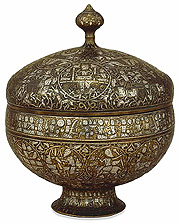
Around 1200 CE
From Khurasan, possibly Herat (modern Afghanistan)
Tinned bronze, engraved and inlaid with silver
Height: 21.5 cm
Acquisition number: # OA 1950.7-25.1
Image courtesy of the British Museum (copyright reserved)
Astronomy came to hold a special place in Arab culture, and by the ninth century, Arab and non-Arab Muslim astronomers had compiled sophisticated treatises, star charts, and tables of planetary motion. One focus of this interest in astronomical phenomenon was the calculation of the start and end times for Islam's holy days and periods. These calculations were often accurate almost to the very minute, and allowed Muslims to prepare for such events as Eid-ul-Adha (the Festival of Sacrifice), which begins at the exact moment of with the rising of the crescent moon on the tenth day of the month of Zul-Hijja.
Interest in astronomy led to the use of heavenly imagery by Muslim artists and artisans on objects such as this lidded bowl. As explained by experts at the British Museum, the twelve roundels on the lower half of the bowl contain the personification of a planet with the sign of the zodiac representing its day or night house. On the left is a figure drawing water from a well, identified as Saturn in his night house, Aquarius. On the right, the figure mounted on a ram is Mars in his night house, Aries. The eight roundels on the lid contain personifications of other celestial beings, including the dragon Jawzahr, symbol of the lunar eclipse.1
(1) See the British Museum web page dedicated to this object.